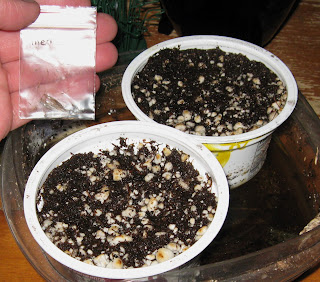Let me preface the rest of this post by stating clearly: I am NOT an expert, or even seasoned grower of carnivorous plants. This is merely what's been working for me. Bright light (direct at my previous home, filtered through a white sheet here), and shallow trays of distilled water. That's it!
Bolstered by these encouraging experiences, I decide to try growing Nepenthes (tropical pitcher plant) from seed. I bought Nepenthes inermis off Ebay from a grower in Indonesia, even though I'd read on several forums that this practice can be futile since seeds need to be fresh in order to germinate properly. They weren't very expensive, so I figured it would be worth a try. First I filled these plastic cups with a carnivorous plant soil mix I bought from Cobraplants.com, and placed them in a plastic tray.
Here are the seeds with the pod...
...before planting I soaked the soil cups in distilled water for two days to ensure they would be moist enough (I spritzed the soil surface, too).
According to the instructions that came with the seeds, they are to be scattered on the surface. I was tempted to push a few under the soil too, but figured I'd play by the rules this first time.
I had to use tweezers to handle them...
...okay now-grow!
I spritzed them down with distilled water to ensure good soil contact...
...then set one cup next to an established sundew (currently in its' annual dieback, pardon the drooping).
The other cup will go under the LED grow light to see how that goes. I just hope at least one seed sprouts somewhere, but only time will tell.
As for the carns I have growing currently-these two are in need of division to their own pots, but were so small when I got them that one pot seemed big enough. I bought this Nepenthes bicalcarata (a.ka. "Fang") from Carnivorous Plant Nursery, and they included a free bonus sundew Drosera capensis. They both arrived in decent shape but were small and un-potted. I put them together in here, but will repot to seperate quarters soon.
This is the happy plant that inspired my carnivorous confidence-Nepenthes unknown (I bought it in 2008 from a big garden store in Green Bay, and the tag it came with just had a silly cartoon and some basic cultural info). One thing the tag said was to keep it "moist but not soggy", which to me says "impossibly fussy about moisture". When I first tried to grow carns, I followed this acvice and they died. So when I got this nepenthes, I kept it in a tray of distilled water at all times. This is how it responded, so that's my new growing rule.
There's even a baby plant growing alongside, with pitchers and everything!
Just goes to show that even the largest consensus of garden advice can be ignored with good results. So blaze your own trail, no matter what the experts say. Success is in the results anyhow!




















